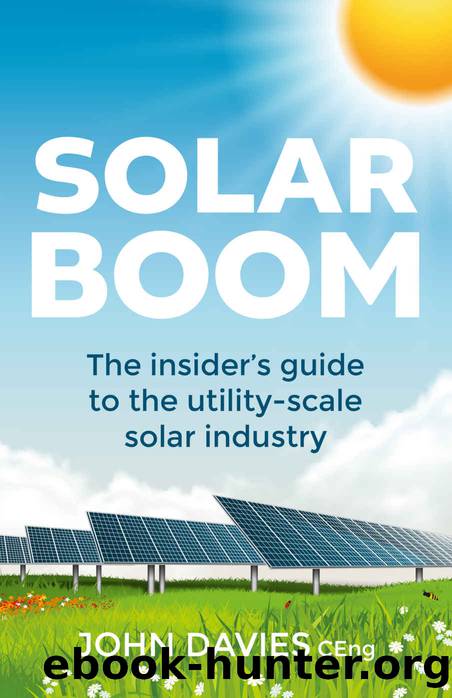Solar Boom: The insider's guide to the utility - scale solar industry by John Davies

Author:John Davies [Davies, John]
Language: eng
Format: epub
Publisher: Rethink Press
Published: 2021-09-27T22:00:00+00:00
Revamp and repower defined
What do ârevampâ and ârepowerâ mean?
The term ârevampâ can relate to a range of planned improvements or even optimisation measures which can be applied to a site to increase its performance, safety and longevity, but without major changeouts or exchanges of major components.
Some in the industry may argue that repowering only occurs when you exchange or upgrade the power conversion element of the asset (ie the inverters). However, exchanging a siteâs modules (the power-generating component within a solar farm) â for example, by replacing 250 W modules with 350 W modules â requires a repowering engineering exercise. This is not just a case of swapping the components over. Youâd need to calculate string lengths and configurations and factor in the effects on the inverters and protection settings as well as the interface with the mounting structure, OFGEM and planning considerations. I would also classify this type of project as ârepoweringâ.
The most common repowering project, although new to the industry, is the exchange of the inverter technology. Since the early 2010s, many inverter brands have come and gone, leaving asset owners with unreliable inverter sets, lowered performance levels, little to no spares, no specialist technical in-house or external expertise or support, and a question mark over the long-term viability of the asset. Most of the inverter repowering projects Iâve heard about in Europe involve the exchange of a centralised inverter set. The exchange may be âlike for likeâ, where existing inverters are replaced with inverters that have similar power classes, inputs and outputs, and footprints. Others adopt a more interesting and innovative approach, taking advantage of the AC and DC cable design on the site (minimising costs in installing new) and re-designing a centralised string-inverter arrangement, placing multiple string inverters in a single location. This may be a containerised or a building-type structure containing multiple string inverters. This strategy has several advantages:
If an inverter goes down, only a small part of the system is not producing, compared to sites with a centralised inverter.
In terms of O&M, having all of the string inverters in one place rather than dotted around the field will save time and money in the long term.
String inverters are easily fixable and/or exchangeable. O&M companies will hold several spares on-site to minimise downtime.
Procurement quality assurance measures can be employed to ensure that the inverter brandâs manufacturer is in it for the long term. This would not have been done several years ago.
Coupled with in-line IV-curve tracing and module-level real-time analysis, string-inverter systems have several more advanced operational and asset management advantages over their centralised counterparts.
Download
This site does not store any files on its server. We only index and link to content provided by other sites. Please contact the content providers to delete copyright contents if any and email us, we'll remove relevant links or contents immediately.
Whiskies Galore by Ian Buxton(41490)
Introduction to Aircraft Design (Cambridge Aerospace Series) by John P. Fielding(32857)
Small Unmanned Fixed-wing Aircraft Design by Andrew J. Keane Andras Sobester James P. Scanlan & András Sóbester & James P. Scanlan(32534)
Craft Beer for the Homebrewer by Michael Agnew(17902)
Turbulence by E. J. Noyes(7660)
The Complete Stick Figure Physics Tutorials by Allen Sarah(7097)
Kaplan MCAT General Chemistry Review by Kaplan(6548)
The Thirst by Nesbo Jo(6407)
Bad Blood by John Carreyrou(6245)
Modelling of Convective Heat and Mass Transfer in Rotating Flows by Igor V. Shevchuk(6207)
Learning SQL by Alan Beaulieu(5995)
Weapons of Math Destruction by Cathy O'Neil(5779)
Man-made Catastrophes and Risk Information Concealment by Dmitry Chernov & Didier Sornette(5593)
Digital Minimalism by Cal Newport;(5325)
Life 3.0: Being Human in the Age of Artificial Intelligence by Tegmark Max(5147)
iGen by Jean M. Twenge(5126)
Secrets of Antigravity Propulsion: Tesla, UFOs, and Classified Aerospace Technology by Ph.D. Paul A. Laviolette(4863)
Design of Trajectory Optimization Approach for Space Maneuver Vehicle Skip Entry Problems by Runqi Chai & Al Savvaris & Antonios Tsourdos & Senchun Chai(4807)
Electronic Devices & Circuits by Jacob Millman & Christos C. Halkias(4701)
